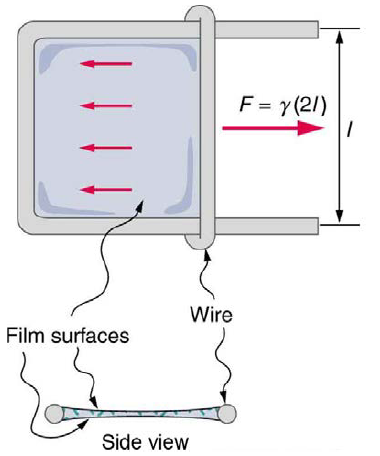
Concept explainers
Calculate the force on the slide wire in Figure 11.29 if it is 3.50 cm long and the fluid is ethyl alcohol.

Figure 11.29 Sliding wire device used for measuring surface tension; the device exerts a force to reduce the film's surface area. The force needed to hold the wire in place is F=γL=γ(2l) , since there are two liquid surfaces attached to the wire. This force remains nearly constant as the film is stretched, until the film approaches its breaking point.
Want to see the full answer?
Check out a sample textbook solution
Chapter 11 Solutions
College Physics
Additional Science Textbook Solutions
Physics for Scientists and Engineers: A Strategic Approach, Vol. 1 (Chs 1-21) (4th Edition)
College Physics: A Strategic Approach (3rd Edition)
Fundamentals of Anatomy & Physiology (11th Edition)
Campbell Essential Biology (7th Edition)
Genetic Analysis: An Integrated Approach (3rd Edition)
Introductory Chemistry (6th Edition)
- 1. At 0°C a steel cable is 1km long and 1cm diameter when it is heated it expands and its resistivity increases. Calculate the change in resistance of the cable as it is heated from 0-20°C The temperature coefficient of resistance a, gives the fractional increase in resistance per °C. So increase in resistance AR = Ra.AT Where R, is the resistance at 0°C For steel a, 0.003 °C The coefficient of linear expansion a- gives the fractional increase in length per °C temperature rise. So increase in Length AL La-AT Where L, is the length at 0°C For steel a₁ = 12 x 10 °C-1 The resistivity of steel at 0°C = 1.2 x 10 Qmarrow_forward1. F E 6V 10 1.1. B a 6V b C C Apply Kirchoff's 1st law to point C for the circuit above Apply Kirchoff's 2nd Law to loops: a. ABCFA b. ABDEA C. FCDEF d. Find values for currents a,b and c Darrow_forward2. The results of the Rutherford experiment can be categorized in 3 statements. Fill in the missing words Most 11. Some III. A few State which result gives evidence that the nucleus is a. heavier than an alpha particle b. very small compared to the size of the atom c. positively charged 3. Using values in the diagram derive an expression for r .0 e marrow_forward
- 3. A 100 W light bulb is connected to 230 V mains supply by a cable with resistance 0.12. Determine the heat loss per second by the cable.arrow_forward1. The image shows electrons flowing in a conductor with cross sectional area 1mm². A electron flow • Add an arrow showing the direction of current. B • Which end has the highest potential? • Calculate the current when 1019 electrons flow through the wire in 10 s. If there are 1026 electrons per unit volume what is the drift velocity of the electrons?arrow_forwardpls helparrow_forward
- No chatgpt pls will upvote Already got wrong chatgpt answerarrow_forwardPART III - RESISTORS IN PARALLEL Consider (but do not yet build) the circuit shown in the circuit diagram to the left, which we will call Circuit 3. Make sure you are using Bert bulbs. You may want to wire two batteries in series rather than use a single battery. 7. Predict: a) How will the brightness of bulb B3A compare to the brightness to bulb B3B? c) X E B3A b) How will the brightness of bulb BзA compare to the brightness of bulb B₁ from Circuit 1? How will the currents at points X, Y, and Z be related? www d) How will the current at point X in this circuit compare to the current at point X from Circuit 1? Y Z B3B wwwarrow_forwardPART II - RESISTORS IN SERIES Consider (but do not yet build) the circuit shown in the circuit diagram to the left, which we will call Circuit 2. Make sure you are using Bert bulbs. You may want to wire two batteries in series rather than use a single battery. 4. Predict: a) How will the brightness of bulb B₂ compare to the brighness to bulb B2B? X B2A E Y B2B Ꮓ b) How will the brightness of bulb B2A compare to the brightness of bulb B₁ from Circuit 1? c) How will the currents at points X, Y, and Z be related? d) How will the current at point X in this circuit compare to the current at point X from Circuit 1?arrow_forward
 Principles of Physics: A Calculus-Based TextPhysicsISBN:9781133104261Author:Raymond A. Serway, John W. JewettPublisher:Cengage Learning
Principles of Physics: A Calculus-Based TextPhysicsISBN:9781133104261Author:Raymond A. Serway, John W. JewettPublisher:Cengage Learning Physics for Scientists and Engineers: Foundations...PhysicsISBN:9781133939146Author:Katz, Debora M.Publisher:Cengage Learning
Physics for Scientists and Engineers: Foundations...PhysicsISBN:9781133939146Author:Katz, Debora M.Publisher:Cengage Learning College PhysicsPhysicsISBN:9781285737027Author:Raymond A. Serway, Chris VuillePublisher:Cengage Learning
College PhysicsPhysicsISBN:9781285737027Author:Raymond A. Serway, Chris VuillePublisher:Cengage Learning College PhysicsPhysicsISBN:9781305952300Author:Raymond A. Serway, Chris VuillePublisher:Cengage Learning
College PhysicsPhysicsISBN:9781305952300Author:Raymond A. Serway, Chris VuillePublisher:Cengage Learning College PhysicsPhysicsISBN:9781938168000Author:Paul Peter Urone, Roger HinrichsPublisher:OpenStax College
College PhysicsPhysicsISBN:9781938168000Author:Paul Peter Urone, Roger HinrichsPublisher:OpenStax College Physics for Scientists and EngineersPhysicsISBN:9781337553278Author:Raymond A. Serway, John W. JewettPublisher:Cengage Learning
Physics for Scientists and EngineersPhysicsISBN:9781337553278Author:Raymond A. Serway, John W. JewettPublisher:Cengage Learning





